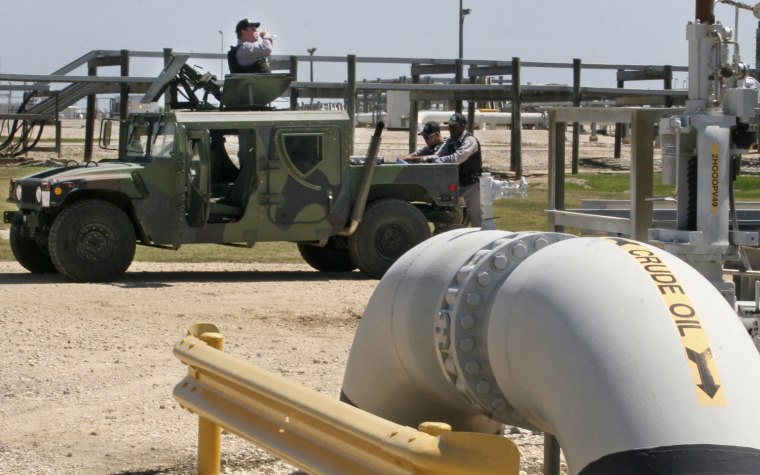Thursday’s surprise release of 60 million barrels of crude reserves is not about keeping oil consumers well supplied. It’s about chasing oil speculators out of the market.
And it seems to be working.
“This is the straw that breaks the camel’s back — this is the tipping point,” said Fadel Gheit, oil analyst for Oppenheimer, a leading investment bank. “The speculators will have to change their positions. Instead of betting on higher prices they have to bet on lower prices."
In a coordinated move, U.S. and European energy officials announced they would release 60 million barrels of oil from strategic stockpiles over the next month after OPEC failed this month to agree on an increase in production. Those extra OPEC barrels were supposed to replace crude output lost when civil war in Libya shut down production.
"This supply disruption has been underway for some time and its effect has become more pronounced as it has continued," said the International Energy Agency in a statement. It said expectations were that Libyan production would remain off the market for the rest of 2011.
"Greater tightness in the oil market threatens to undermine the fragile global economic recovery," it said.
But independent analysts said the move was aimed more at bursting the speculative bubble rather than substantially improving market supply. Lowering oil prices further would help boost the weak U.S. economy at a time when both the Fed’s monetary stimulus and the government’s spending stimulus are winding down.
Based on the market's immediate response, the plan seems to be working.
News of the oil release sent gasoline tumbling 14 cents a gallon in the futures markets. That’s the equivalent of about $56 million a day in savings at the gas pump — or about $20 billion a year, according to Peter Beutel, and oil analyst a Cameron Hanover. In New York trading crude oil was down $4.01 to $91.40 a barrel, more than 20 percent below peak levels of $114 hit in early May.
“It’s a shot in the arm for the economy,” said Beutel. “It acts like a massive tax rebate to the American consumer.”
But the amount of oil to be released — about 2 million barrels a day for 30 days —represents just a tiny fraction of the global demand of some 84 million barrels so will have little impact on supply.
In fact, there’s little evidence that the latest surge in oil prices is the result of strong demand straining tight supplies. Despite the loss of Libyan production, about 1.5 million barrels a day, oil markets are well supplied — largely because OPEC countries have been producing well above their official quotas.
“I don't see what the release of 60 million barrels of oil adds to the market," said Christophe Barret, an oil analyst at Credit Agricole. “We don't need it in terms of levels of stocks; we are 35 million barrels above the five-year average already. It's the equivalent of two months (of) Libyan production, so I'm not sure it will make much difference."
On the demand side, a weakening economy also has eased the pressure on prices. Sluggish economic growth in the U.S. and Europe has cut into oil consumption. Gasoline prices that ran up to a peak of about $4 a gallon nationwide forced many drivers to cut back.
Despite adequate supplies and weakening demand, oil has been trading well over $100 a barrel. That's prompted calls to try to eliminate the added premium created by investors who have placed big bets on higher oil prices. Earlier this month, French President Nicolas Sarkozy called for tighter controls on the speculators, whom he blames for spiraling food and energy prices.
Chasing speculators out of the market could have a substantial and rapid impact on prices.
"Over 60 to 70 percent of the oil market is speculative," said Gulf Oil chief executive Joseph Petrowski. "When the market starts to perceive for one reason or another that either supply is getting more ample or there's going to be less demand or the economy is weaker, you flush out the speculative interest. So prices grind up and then we bang down."
Oil market watchers like Gheit say that — based solely on the fundamental forces supply and demand — oil should be trading about $20 below current levels.
"I think the IEA is trying to act like a central bank," said Dominick Chirichella, founding member of the Energy Management Institute in New York. "With the IEA dumping two million barrels a day onto the market, I don't think anyone will be comfortable being long on oil. I think U.S. oil prices will trade in the $85 to $92 a barrel range going forward. We may see oil trading in the 80s very soon."
Although the volume of oil to be released is small, there is plenty more available if the initial round doesn’t achieve the desired impact. Total strategic reserves of the global consumer nations in the IEA top 1.6 billion barrels, including 727 million barrels in the U.S. Strategic Petroleum Reserve.
So anyone betting on a continued rise in oil prices runs the risk that Thursday’s release is just the first of many aimed at lowering prices. Removing those speculators from the market would eliminate the premium paid to cover the profits generated by investors, said Gheit.
“I want all the gamblers to lose everything they own,” he said. “We're paying for it when these guys are betting with someone else's money. And the consumers are the ones losing money."
